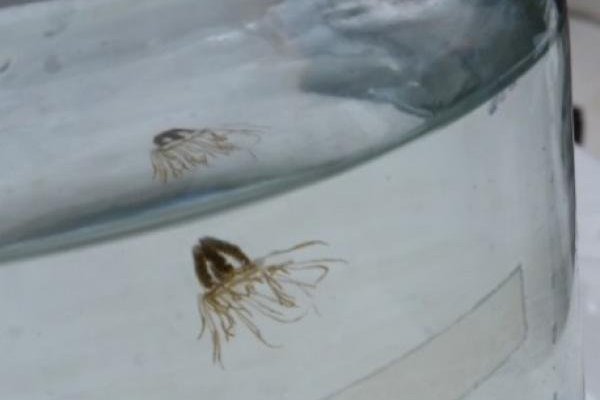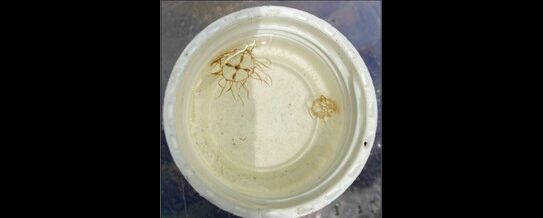
July 05, 2023
 Source/New Jersey Department of Environmental Protection
Source/New Jersey Department of Environmental Protection
Clinging jellyfish, an invasive species that can inflict dangerous and painful stings, are back in some Jersey Shore estuaries and bays for the seventh consecutive summer.
Tiny-but-mighty clinging jellyfish are back in New Jersey coastal waters for the seventh consecutive summer.
Shore goers are warned to keep their eyes out for the coin-sized cnidarians, which attach themselves to algae or marine vegetation in bay and estuarine waters and can inflict powerful stings, according to the New Jersey Department of Environmental Protection.
"I think what the DEP is trying to let the public know is that there are these clinging jellies in the water," said Christine Thompson, an associate professor of marine science at Stockton University. "So, you know, exercise caution if you're in an area that has submerged vegetation."
Clinging jellyfish grow to be about 1 inch in diameter. The body of an adult, known as a medusa, appears mostly transparent with a distinctive cross-shape in the center that ranges in color from red-orange to yellow. They have 60 to 80 tentacles of differing sizes that contain stinging cells, or nematocysts, which pack a painful punch.
The invasive species is native to the Pacific Ocean but likely was introduced to the eastern Atlantic coast by ships in the late 19th century. The species was first reported at the Jersey Shore in 2016, when a fisherman at Barnegat Bay caught what appeared to be a clinging jellyfish. A Monmouth County man was hospitalized a week later after being stung by one in the Shrewsbury River, and the species made its way to North Wildwood in 2019.
The tiny jellies now can be found along the East Coast from Maine to New Jersey. Like other jellyfish, clinging jellies begin to bloom, or increase in population, in mid-May when water temperatures and food sources become favorable. Clinging jellies can be seen through early August, or until bay water temperatures reach 82 degrees Fahrenheit.
Clinging jellyfish populations are established in several New Jersey locations, including the Metedeconk River, the bayside of Island Beach State Park, the Shrewsbury River, a salt pond in North Wildwood adjacent to Hereford Inlet Lighthouse, the Lower Township Thorofare coastal waterway and the Cape May National Wildlife Refuge.
An interactive map is updated weekly with confirmed clinging jellyfish locations. Scientists from the NJDEP and Montclair State University are monitoring areas where the species is established and investigating reported sightings and places with suitable clinging jellyfish habitats.
A study commissioned in May through a collaboration between the NJDEP and Rutgers University has made it easier to monitor New Jersey's cnidarians – a group of marine predators with stinging cells, including jellyfish – by testing water samples for the DNA the animals release into their environments.
The NJDEP also relies on information from the public to keep tabs on clinging jellyfish populations. Anyone who spots a clinging jellyfish is asked to take a photo, if safely possible, and send GPS coordinates to joseph.bilinski@dep.nj.gov.
Adult clinging jellyfish spend the daytime hours lodged in eelgrass or algae, in areas where zooplankton and copepods are abundant, but they become active after sunset or if disturbed. Clinging jellyfish are not typically found in ocean waters or on beaches, but people casually wading or gathering shellfish in eelgrass beds could be at risk. A jellyfish that has been disturbed may dart to the surface and potentially make contact with a person moving through.
Clinging jellyfish, pictured above, have been confirmed in some bay and estuarine waters of New Jersey this summer. The non-native species, which can inflict a painful sting, was first spotted at the Jersey Shore in 2016.
Thompson has not come into contact with any clinging jellyfish this summer while working in lower Barnegat Bay with students on oyster research, but she said that a member of her group recently suffered a minor sting by an unidentified creature while scraping algae and organisms off of a dock to obtain samples. She urged people to be vigilant of all the stinging creatures that may reside in Jersey Shore waters.
"If people are boating and get out and go swimming, they should be aware of where they are and if there is any submersed aquatic vegetation, they should potentially take caution," Thompson said. "Keep an eye out for what's in the water ... There are stinging things everywhere, if you're unlucky enough, but generally you should exercise caution if you're in an area and you can't see what's growing there."
To avoid coming in contact with a clinging jellyfish, the public is urged not to wade into areas where the species has been observed. Wearing waders and long-sleeved clothing into those waters reduces the risk of being stung.
Reactions to a clinging jellyfish sting vary from person to person, but they usually begin with a burning sensation. In severe cases, a clinging jellyfish sting can lead to hospitalization and kidney failure. A researcher with the Woods Hole Oceanographic Institute, who was stung in the face in 2013, likened the pain to "hypodermic needles."
If stung by a clinging jellyfish, NJDEP officials recommend rinsing the area with saltwater and removing tentacle materials by using gloves, a plastic card or a thick towel. If symptoms persist or pain worsens, the victim should promptly seek medical attention.
Follow Franki & PhillyVoice on Twitter: @wordsbyfranki
| @thePhillyVoice
Like us on Facebook: PhillyVoice
Have a news tip? Let us know.
 Source/New Jersey Department of Environmental Protection
Source/New Jersey Department of Environmental Protection